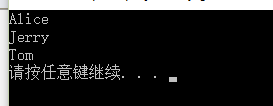极客班 C++ STL (容器算法)第二周笔记
标签(空格分隔): C++
1. 容器(下)
1.1 Stack
a. 概述
Stack 是一种先进先后出(First In Last Out)的数据结构,只有一个出口。 特点:
- 支持的操作有
-
- push , pop , top
-
- 只能访问顶端元素,不允许便利
- 要使用Stack,必须引入<stack> 头文件(标准库)
#include<stack>
int main()
{
std::stack<int> s; //必须提供泛化参数
s.push(1); //将1压栈
s.pop(); //弹出栈顶元素
s.size(); //获取栈大小
return 0;
}
b. Stack的底层数据结构(1)
查看标准库头文件,我们可以知道,STL stack是以deque作为默认底层结构的:
// TEMPLATE CLASS stack
template<class _Ty,
class _Container = deque<_Ty> >
class stack
{ // LIFO queue implemented with a container
//...
}
联系我们在C++ OOP面向对象设计接触到的方法,这种设计就是一种对既有接口的包装,适配,即采用了adapter模式。该模式在这里是包装了deque,并给出了push/pop/top等栈特有的接口。
由于stack不允许遍历,所以没有iterator。
c. Stack的底层数据结构(2)
在 1.1小节中,我们看到了stack的底层定义,发现在模板参数里的容器选项中,是传入了一个deque<_Ty>作为默认参数。 所以,我们除了deque<T>,list<T>其实也是可以拿来作为底层的数据结构的。
//e.g.
std::stack<int, std::list<int>> s;
s.push(1);
s.pop();
s.top();
s.size();
1.2 Queue
a. 概述
Queue呢,就是一种先进先出的数据结构, 有两个出口。 - 支持四种操作:push(增加元素),移除元素(pop),获取最前面的元素(front),获取最后面的元素(back) - 只能访问最前或者最后的元素 - 需要引入标准库<queue>才可以使用
#include<queue>
int main()
{
std::queue<int> q;//初始化一个存放int型别的队列
q.push(1); //插入元素
q.pop(); //移除元素
q.back(); //获取最后一个元素
q.front(); //获取最前面的元素
}
b. queue的底层数据结构(1)
查看标准库,我们可知,与stack一样,queue也是包装了deque<T>
// TEMPLATE CLASS queue
template<class _Ty,
class _Container = deque<_Ty> >
class queue
{ // FIFO queue implemented with a container
//...
}
有了这一层的认识,我们可以知道,由于不允许遍历,和stack一样所以queue也没有迭代器(iterator)。
c. queue的底层数据结构(2)
跟stack类似,queue也是可以以list作为底层数据结构的。具体示例暂时不给出了(接口不变,只是换了底层实现)。
1.3 Map and Multimap
1.3.1 Map 概述
Map的特性
- 是一种关联容器,存储的是key/value pair
- 不允许key重复
- map存储的对象必须是具有可排序性的
// TEMPLATE CLASS map
template<class _Kty,
class _Ty,
class _Pr = less<_Kty>,
class _Alloc = allocator<pair<const _Kty, _Ty> > >
class map
: public _Tree<_Tmap_traits<_Kty, _Ty, _Pr, _Alloc, false> >
{ // ordered red-black tree of {key, mapped} values, unique keys
//...
}
其中,
_Kty就是对应的键key_Ty就是对应的值value_Pr对应的排序算法,默认是less<T>算法,即按_Kty排序,那么,_Kty必须要实现比较操作符operator <- 我们也可以自定义算法(通过仿函数来实现)
_Alloc内存分配算法(针对这个键值对的)
1.3.2 例子
//STL_test.h
//map value
struct Employee {
Employee(){}
Employee(const std::wstring& wszName):Name(wszName){}
std::wstring Name;
void print() const
{
std::wcout << Name << "\n";
}
};
//仿函数,定义比较大小
struct ReversId :public std::binary_function<int, int, bool>
{
bool operator()(const int& key1, const int &key2)
{
return (key1 <= key2) ? false : true;
}
};
//for_each 打印
struct FunctorPrintMapValue{
void operator()(const std::pair<int, Employee> pair)
{
pair.second.print();
}
};
//STL_test.cpp
int main()
{
const int size = 3;
std::pair<int, Employee> items[size] = {
std::make_pair(1, Employee(L"Tom")),
std::make_pair(2, Employee(L"Jerry")),
std::make_pair(3, Employee(L"Alice"))
};
std::map<int, Employee, ReversId> m(items, items + size);
std::for_each(m.begin(), m.end(), FunctorPrintMapValue());
system("pause");
return 0;
}
结果:

我们可以看出,按照自定义的less算法,确实实现了按key倒排序。
1.4 Set and Multset
set 跟map略有不一样,感觉上像是map的特殊版本,因为,在set中,
- 存储的对象本身,既是
key,又是value。 - 不允许有重复的
key set存储的对象,必须是具有可排序性- 要达到这个目标,那么存储的对象必须实现了
operator <操作符 - 支持自定义排序行为(通过仿函数实现)
- 要达到这个目标,那么存储的对象必须实现了
- 必须是引入<set>标准库,通过std::set 访问
下面是一个示例,接着Employee示例来:
//STL_test.h
//set 按名字比较排序仿函数
struct FunctorEmployeeNameComparer:public std::binary_function<Employee,Employee,bool>
{
bool operator()(const Employee& EmpLeft, const Employee& EmpRight)
{
return EmpLeft.getName() < EmpRight.getName();
}
};
//for_each 打印set
struct FunctorPrintSetValue
{
void operator()(const Employee& emp)
{
emp.print();
}
};
//STL_test.cpp
//2. set
const int nSize = 4;
Employee person[] = {
Employee(L"Tom"),
Employee(L"Jerry"),
Employee(L"Alice"),
Employee(L"Tony")
};
std::set<Employee, FunctorEmployeeNameComparer> epSet(person, person + nSize);
std::for_each(epSet.begin(), epSet.end(), FunctorPrintSetValue());
结果:























 1501
1501

 被折叠的 条评论
为什么被折叠?
被折叠的 条评论
为什么被折叠?








